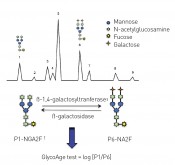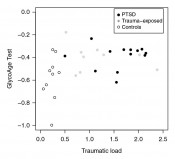|
Scientist
>
Dr Maria Moreno-Villanueva
>
The effects of psychotherapy on DNA damage caused by traumatic stress
The effects of psychotherapy on DNA damage caused by traumatic stressMolecular consequencesThe natural and social environment plays a decisive role in the life of an individual, and has significant repercussions for his or her physical and mental health. Factors in the social environment such as a high population density or noisy cities with traffic congestion and light pollution are considered to be potential stress factors. Social relationships and the working environment also exert a considerable influence on a person’s psyche and state of well-being. In today’s society, stress research is a field that has attracted increasing interest in recent years, fuelled by the growing incidence of striking neurological problems. Research findings show that chemical environmental pollutants such as dioxins, PCBs (polychlorinated biphenyls), pesticides, particulate matter or asbestos in dirty or industrialised residential areas all pose a hazard to our health. Turning to social factors, however, much research has yet to be completed on the ways that issues related to population, education, employment, income, lifestyle, social class and the family trigger psychological disorders, and on the biological mechanisms that are responsible. Background DNA stores all of our genetic information that codes for the proteins essential to life: as a result of this fact, damage to the genetic molecule DNA can endanger the entire organism. DNA damage can occur spontaneously within our cells or can be triggered by external physical factors such as irradiation, reactive oxygen species (ROS) or chemical substances – the latter originating in both food constituents and drugs (chemotherapy). While DNA damage can be repaired in principle, damage left untouched or inadequately remediated leads to mutations, loss of control over cell division (cancers) and even to cell death. N-glycans are heterogeneous chains of sugar molecules. Glycans are bound to proteins via glycosylation. They occur as cell membrane-bound glycoproteins (e.g. receptors, channel proteins, histocompatibility antigens) or in soluble forms (e.g. serum proteins, transport proteins, immunoglobulins, protein hormones). Since the glycosylation of proteins is an age-dependent process, certain glycosylation patterns in human plasma have therefore been described as biomarkers for a person’s biological age [1] (fig.1).
Fig. 1: GlycoAge Test (modified from Vanhooren, V. et al. Exp Gerontol. 2010). Schematic diagram illustrating a number of glycans (peaks P1 to P9) in blood serum. The logarithm of P1-NGA2F (agalactosylated, core-a-1,6-fucosylated biantennary) divided by P6-NA2F (bigalactosylated, core-a-1,6-fucosylated biantennary) constitutes the GlycoAge Test.
Consequences of traumatic stress Experiencing a traumatic event such as rape, abuse, natural disasters or traffic accidents can trigger a post-traumatic stress disorder (PTSD). Current scientific research work is uncovering a connection between traumatic stress and an increased risk of health problems such as heart failure, stroke, high blood pressure, cardiac arrhythmias, obesity and diabetes [2]. Study design In our recently-published interdisciplinary study, we analysed DNA strand breaks and DNA repair in 65 study participants: 34 PTSD patients and 31 control subjects, whereby the control group was subdivided into 11 traumatised individuals and 20 healthy volunteers sharing the same ethnic origin. The group of PTSD and traumatised patients consisted of women and men who had fled to escape war, torture and rape. All test subjects were recruited at the Reichenau Centre for Psychiatry, Konstanz. To investigate the effects of psychotherapy on DNA strand breaks, the PTSD patients were randomly assigned to two separate groups: a treatment group and a wait-list control group. Patients in the treatment group received treatment in the form of narrative exposure therapy (NET) for four months, while patients in the wait-list control group received no NET. Blood samples were taken, and blood cells and plasma extracted from whole blood. The endogenous DNA strand breaks and capability for cellular DNA repair were investigated in key cells of the immune system, in what are termed peripheral mononuclear blood cells (PMBCs). The DNA strand breaks and a repair period of 90 minutes following ex vivo (i.e. in the laboratory test tube) irradiation were quantified with the aid of a fluorescence-detected alkaline DNA unwinding (FADU) assay (fig.2). The N-glycosylation patterns were identified in plasma using DSA-FACE technology.
Fig. 2: Schematic diagram of the FADU method (from Moreno-Villanueva, M., Bürkle, A. (2012) High-throughput assays to quantify the formation of DNA strand breaks. In: P. Steinberg (ed.), High-throughput screening methods in toxicity testing. John Wiley & Sons, Inc., Hoboken, NJ, USA). The cells are shown in the yellow boxes. The light grey boxes show double-stranded DNA with increasing levels of damage while the blue boxes show double-stranded DNA with an increasing degree of unwinding. The small circles in the dark grey boxes represent dye molecules (yellow = no fluorescent signal, and green = fluorescent signal).
Findings Our results show that both patients with a post-traumatic stress disorder and chronically traumatised patients exhibit an elevated number of DNA strand breaks, while irradiation-induced DNA repair reveals no significant differences between the patient group and the control group [3] (fig.3). The clinician-administered PTSD scale (CAPS) is a clinical interview conducted to record the frequency and intensity of symptoms stemming from the post-traumatic stress disorder. We found a significant decrease in CAPS scores with patients receiving NET and – interestingly – a reduction in accumulated DNA strand breaks after receiving psychotherapy [3]. Other studies have already shown a reduction in PTSD symptoms following NET. On the other hand, the positive effect of psychotherapy on molecular-level changes with potential benefits to physical health – such as DNA strand breaks – had not been demonstrated to date.
Fig. 3: DNA strand breaks and DNA repair (from Morath and Moreno et al., Psychother Psychosom. 2014). a) Low fluorescence values indicate a high number of DNA strand breaks. b) DNA repair following X-ray irradiation (= 3.8 Gy at 0 min). Cells were incubated for 10 to 90 minutes at 37 °C to allow them time to repair. As periods grow longer, DNA repair also increases.
One possible cause for the accumulation of DNA strand breaks is an increased concentration of adrenalin in the blood. In stressful situations, adrenalin is released into the blood, binding to adrenergic receptors in cells, where it triggers the rapid provisioning of energy reserves. New research findings show that the chronic stimulation of adrenergic receptors leads to the loss of the “tumour suppressor” protein p53, and, as a consequence, to the accumulation of DNA strand breaks [4]. Furthermore, the immune system responds to the frequent and prolonged occurrence of stress responses by increasing the rate of cytokine production and activating inflammatory processes, in the course of which reactive oxygen species (ROS) are formed. At the molecular level, these ROS lead to a variety of cellular changes. One especially common consequence is the occurrence of DNA strand breaks. Yet the mechanism by which psychotherapy brings about a reduction in DNA strand breaks remains unclear, however. The concentration of certain chains of sugar molecules – the N-glycans – changes in blood plasma with increasing age [1]. In our study, PTSD patients exhibit an N-glycosylation pattern matching that of a healthy individual some 15 years older [5] (fig.4). Researchers have established a link between the immune system, stress and age. Moreover, the N-glycosylation pattern is associated with inflammatory processes in older people, and an increased level of inflammatory immune activity was observed in PTSD patients. Ultimately, changes in N-glycosylation patterns are not merely a biomarker for a person’s physiological age, but are also involved in the genesis of age-associated illnesses.
Fig. 4: GlycoAge score (from Moreno and Morath et al., Translational Psychiatry 2013). Scatterplot between GlycoAge test and traumatic stress. High values in the GlycoAge test correlate positively with an increase in traumatic stress.
Psychological stress is not only harmful to our health but is also a negative factor affecting our communities. Further studies are needed to improve our understanding of the molecular mechanisms of psychological stress. Research strategies need to be developed to help us overcome the stresses of the social milieu on the one hand while also improving our understanding of the molecular mechanisms of psychiatric stress and thus leading to the development of effective treatments.
Bibliography
Picture: © www.istock |
L&M int. 1 / 2015
Free download here: download here The Author: |










